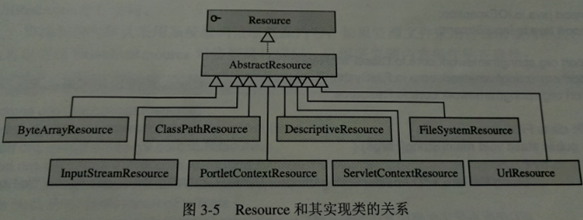Spring -- 资源访问(二)
2017-04-01 09:27
183 查看
知识点的梳理:
Resource接口以及实现类可以脱离Spring框架使用,它比通过JDK访问资源的API好用很多;
资源抽象接口
Spring设计了Resource接口,用来访问底层资源路径;
Resource在Spring中非常重要,Spring使用Resource装载各种资源,这些资源包括配置文件资源,国际化属性文件等;
通过它,可以将Spring的配置信息放置在任何地方(如数据库,LDAP中),只要最终可以通过Resource接口返回配置信息就可以了;
常用方法:
boolean exists():资源是否存在;
boolean isOpen():资源是否打开;
URL getURL() throws IOException:如果底层资源可以表示成URL,该方法返回对应的URL对象;
File getFile() throws IOExceion:如果底层资源对应一个文件,该方法返回对应的File对象;
InputStream getInputStream() throws IOException:返回资源对应的输入流;
Resource的具体实现类
图解

类的解析:
ByteArrayResource:二进制数组表示的资源,二进制数组资源可以在内存中通过程序构造;
ClassPathResource:类路径下的资源,资源以相对于类路径的方式表示;
FileSystemResource:文件系统资源,资源以文件系统路径的方式表示,如:"D:/conf/bean.xml";
InputStreamResource:对应一个InputStream的资源;
ServletContextResource:为访问Web容器上下文中的资源而设计的类,负责以相对于Web应用根目录的路径加载资源,它支持以流和URL的方式访问,在WAR解包的情况下,也可以通过File的方式访问,该类还可以直接从JAR包中访问资源;
UrlResource:封装了java.net.URL,它使用户能够访问任何可以通过URL表示的资源,如文件系统的资源,HTTP资源,FTP资源;
说明:假设有一个文件位于Web应用的类路径下,可通过如下方式访问:
FileSystemResource:以文件系统绝对路径的方式进行访问;
ClassPathResource:以类路径的方式进行访问;
ServletContextResource:以相对于Web应用根目录的方式进行访问;
实例1:通过FileSystemResource和ClassPathResource访问同一个文件资源:
示例2:在WEB应用中,用户可以通过ServletContextResource以相对于Web应用根目录的方式访问文件资源
示例3:资源加载时默认采用系统编码读取资源内容,如果资源文件采用特殊的编码格式,那么可以通过EncodedResource对资源进行编码:
资源加载
为了访问不同类型的资源,必须使用相应的Resource实现类,还是比较麻烦的;
Spring可以通过"classpath:","file"等资源地址前缀识别不同的资源类型;
资源地址表达式:
Spring支持的资源类型地址前缀
Ant风格资源地址支持三种匹配符:
?:匹配文件名中的一个字符;
*:匹配文件名中任意个字符;
**:匹配多层路径;
Ant风格的资源路径示例:
classpath:com/t?st.xml:匹配con类路径下com/test.xml,com/tast.xml或者com/txst.xml;
file :D:/conf/*/xml:匹配文件系统D:/conf目录下所有以XML为后缀的文件;
classpath:com/**/test.xml:匹配con类路径下(当前目录及其子孙目录)的test.xml文件;
classpath:org/springframework/**/*.xml:匹配类路径org/springframework下所有以xml为后缀的文件;
classpath:org/**/servlet/bla.xml:匹配类路径org/springfamework/servlet/bla.xml,也匹配org/springframework/testing/servlet/bla.xml,还匹配org/servlet/bla.xml
资源加载器
Spring定义了一套资源加载的接口,并提供了实现类;

ResourceLoader
ResourcePatternResolver扩展ResourceLoader接口,定义了一个新的接口方法getResource(String locationPattern),此方法支持带资源类型前缀及ANT表达式;
PathMatchingResourcePatternResolver是Spring提供的标准实现类
示例:
Resource接口以及实现类可以脱离Spring框架使用,它比通过JDK访问资源的API好用很多;
资源抽象接口
Spring设计了Resource接口,用来访问底层资源路径;
Resource在Spring中非常重要,Spring使用Resource装载各种资源,这些资源包括配置文件资源,国际化属性文件等;
通过它,可以将Spring的配置信息放置在任何地方(如数据库,LDAP中),只要最终可以通过Resource接口返回配置信息就可以了;
常用方法:
boolean exists():资源是否存在;
boolean isOpen():资源是否打开;
URL getURL() throws IOException:如果底层资源可以表示成URL,该方法返回对应的URL对象;
File getFile() throws IOExceion:如果底层资源对应一个文件,该方法返回对应的File对象;
InputStream getInputStream() throws IOException:返回资源对应的输入流;
Resource的具体实现类
图解

类的解析:
ByteArrayResource:二进制数组表示的资源,二进制数组资源可以在内存中通过程序构造;
ClassPathResource:类路径下的资源,资源以相对于类路径的方式表示;
FileSystemResource:文件系统资源,资源以文件系统路径的方式表示,如:"D:/conf/bean.xml";
InputStreamResource:对应一个InputStream的资源;
ServletContextResource:为访问Web容器上下文中的资源而设计的类,负责以相对于Web应用根目录的路径加载资源,它支持以流和URL的方式访问,在WAR解包的情况下,也可以通过File的方式访问,该类还可以直接从JAR包中访问资源;
UrlResource:封装了java.net.URL,它使用户能够访问任何可以通过URL表示的资源,如文件系统的资源,HTTP资源,FTP资源;
说明:假设有一个文件位于Web应用的类路径下,可通过如下方式访问:
FileSystemResource:以文件系统绝对路径的方式进行访问;
ClassPathResource:以类路径的方式进行访问;
ServletContextResource:以相对于Web应用根目录的方式进行访问;
实例1:通过FileSystemResource和ClassPathResource访问同一个文件资源:
| public class FileSourceExample { public static void main(String[] args) { try { String filePath = "D:/masterSpring/chapter3/WebRoot/WEB-INF/classes/conf/file1.txt"; //1.使用系统文件路径方式加载文件 Resource res1 = new FileSystemResource(filePath); //2.使用类路径方式加载文件 Resource res2 = new ClassPathResource("conf/file1.txt"); InputStream ins1 = res1.getInputStream(); InputStream ins2 = res2.getInputStream(); System.out.println("res1:"+res1.getFilename()); System.out.println("res2:"+res2.getFilename()); } catch (IOException e) { e.printStackTrace(); } } } |
| 获取资源后,可通过Resource接口定义的多个方法访问文件的资源: getFileName():获取文件名; getFile():获取资源对应的File对象; getInputStream():直接获取文件的输入流; createRelative(String relativePath):在资源相对地址上创建新的文件; |
| resource.jsp文件 |
| <%@ page language="java" contentType="text/html; charset=utf-8" pageEncoding="utf-8"%> <jsp:directive.page import="org.springframework.web.context.support.ServletContextResource"/> <jsp:directive.page import="org.springframework.core.io.Resource"/> <jsp:directive.page import="org.springframework.web.util.WebUtils"/> <% //注意文件资源地址以相对于WEB应用根路径的方式表示 Resource res3 = new ServletContextResource(application,"/WEB-INF/classes/conf/file1.txt"); out.print(res3.getFilename()+"<br/>"); out.print(WebUtils.getTempDir(application).getAbsolutePath()); %> |
| import org.springframework.core.io.ClassPathResource; import org.springframework.core.io.Resource; import org.springframework.core.io.support.EncodedResource; import org.springframework.util.FileCopyUtils; public class EncodedResourceExample { public static void main(String[] args)throws Throwable { Resource res = new ClassPathResource("conf/file1.txt"); EncodedResource encRes = new EncodedResource(res,"UTF-8"); String content = FileCopyUtils.copyToString(encRes.getReader()); System.out.println(content); } } |
为了访问不同类型的资源,必须使用相应的Resource实现类,还是比较麻烦的;
Spring可以通过"classpath:","file"等资源地址前缀识别不同的资源类型;
资源地址表达式:
Spring支持的资源类型地址前缀
| 地址前缀 | 示例 | 对应资源类型 |
| classpath: | classpath:com/baobaotao/beanfactory/beans.xml | 从类路径中加载资源,classpath:和classpath:/是等价的,都是相对于类的根路径。资源文件可以在标准的文件系统中,也可以在jar或zip的类包中 |
| classpath*: | | 如果有多个文件系统路径拥有相同的包名(如,com.baobaotao),"classpath:"只会在第一个加载的com.baobaotao包下查找。而"classpath*:"会扫描所有的com.baobaotao类路径 |
| file: | file :/comf/com/baobaotao/beanfactory/beans.xml | 使用UrlResource从文件系统目录中装载资源,可采用绝对或相对路径 |
| http:// | http ://www.baobaotao.com/resource/beans.xml | 使用UrlResource从web服务器中装载资源 |
| ftp:// | ftp: //www.baobaotao.com/resource/beans.xml | 使用UrlResource从FTP服务器装载资源 |
| 没有前缀 | com/baobaotao/beanfactory/beans.xml | 根据ApplicationContext具体实现类采用对应的类型的Resource |
?:匹配文件名中的一个字符;
*:匹配文件名中任意个字符;
**:匹配多层路径;
Ant风格的资源路径示例:
classpath:com/t?st.xml:匹配con类路径下com/test.xml,com/tast.xml或者com/txst.xml;
file :D:/conf/*/xml:匹配文件系统D:/conf目录下所有以XML为后缀的文件;
classpath:com/**/test.xml:匹配con类路径下(当前目录及其子孙目录)的test.xml文件;
classpath:org/springframework/**/*.xml:匹配类路径org/springframework下所有以xml为后缀的文件;
classpath:org/**/servlet/bla.xml:匹配类路径org/springfamework/servlet/bla.xml,也匹配org/springframework/testing/servlet/bla.xml,还匹配org/servlet/bla.xml
资源加载器
Spring定义了一套资源加载的接口,并提供了实现类;

ResourceLoader
ResourcePatternResolver扩展ResourceLoader接口,定义了一个新的接口方法getResource(String locationPattern),此方法支持带资源类型前缀及ANT表达式;
PathMatchingResourcePatternResolver是Spring提供的标准实现类
示例:
| import org.springframework.core.io.Resource; import org.springframework.core.io.support.PathMatchingResourcePatternResolver; import org.springframework.core.io.support.ResourcePatternResolver; public class PatternResolverTest { public static void main(String[]args) throws Throwable{ ResourcePatternResolverresolver = new PathMatchingResourcePatternResolver(); //加载所有类包com.baobaotao(及子孙包)下的以XML为后缀的资源 Resourceresources[] =resolver.getResources("classpath*:com/baobaotao/**/*.xml"); for(Resourceresource:resources){ System.out.println(resource.getDescription()); } } } |
相关文章推荐
- Spring中ApplicationContext对资源访问
- Spring 资源访问剖析和策略模式应用
- Spring 资源访问剖析和策略模式应用
- Java学习之道:[续]Spring学习笔记 -- 资源访问(Resource接口)
- Java学习之道:Spring学习笔记 -- 资源访问(Resource接口)
- 使用Spring访问资源文件
- Spring3 MVC 深入研究--访问静态资源
- 【第四章】 资源 之 4.3 访问Resource ——跟我学spring3
- Spring的资源访问
- Spring资源访问
- 备忘:在web.xml中使用org.springframework.js.resource.ResourceServlet的配置对静态资源的访问
- Spring 资源访问剖析和策略模式应用
- Spring 资源访问剖析和策略模式应用
- spring资源访问Resource类
- Spring资源访问
- Spring中的资源访问
- Spring 资源访问剖析和策略模式应用
- 【第四章】 资源 之 4.3 访问Resource ——跟我学spring3
- Spring 资源访问剖析和策略模式应用
- Spring之资源访问
